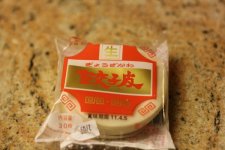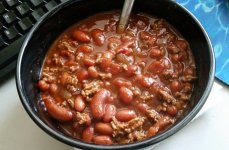Gyoza
Last night I went over to my brother's house, and we made a metric crap-ton of homemade gyoza (more than 200, less than 300).
This is something of a ritual in Japanese-American households. Gyoza (Japanese pot stickers) is incredibly labor-intensive to make, so making them in really large quantities is a whole family affair. I honestly have no idea if Japanese families make gyoza in such massive quantities, but it's pretty common in Japanese-American households. It's kind of a family bonding activity that is part of the Japanese-American experience, so I'm glad my nephew got a chance to do it (he's only a quarter Japanese and doesn't get exposed to much Japanese or Japanese-American stuff).
We had to compromise and use Chinese wrappers (Japanese gyoza wrappers are thinner) because no one felt like driving extra just for wrappers. Good thing too, because partway through we realized we needed twice as many wrappers and my sister in law was nice enough to run out and buy some. If she had to drive all the way to the Japanese grocery, the wrapper-run would never have happened.
Anyway, if anyone is interested, here's the recipe:
Stuffing
- Ground pork and/or beef (we used both).
- Thin-sliced nappa cabbage or bok choy (make the pile of cabbage slightly smaller than the pile of ground meat)
- Thin-sliced green onions (make the pile [ent]frac12[/ent] to [ent]frac23[/ent] as big as the cabbage pile)
- (optional) Diced fresh shiitake mushrooms (pile should be around the same size as green onions, maybe a little less)
- Shredded carrots (do not buy pre-shredded; use a cheese grater as that will make the carrot slices thinner) (pile should be about half as big as the pile of green onions, maybe even less as it's mostly there for color)
Stuffing marinade
- Soy sauce
- Rice vinegar (less vinegar than soy sauce)
- Fresh garlic (use a garlic press) (use pretty aggressive quantities)
- Fresh ginger (ground/grated fine) (use pretty aggressive quantities)
- (optional) good dark sesame oil (pref. Korean or Japanese, you only need a tiny bit)
Combine the ground meat and marinade ingredients in a large bowl and mix with your hands. This allows the meat to start marinating while you're chopping up the various veggies. Once you get all the veggies chopped up, get your hands dirty and mix it all up again. Cover with plastic wrap and let it marinate for at least a half hour.
Wrappers
If you feel ambitious or can't buy wrappers at the grocery, it's just flour and water. Just make sure you knead it extra vigorously to develop a lot of gluten, as you'll need it to be stretchy/rubbery enough to handle all the mangling without tearing. Roll the dough thin, and use an old empty can (or something similar) to cut it into circles. The wrappers should be thin and about 3 to 3[ent]frac12[/ent] inches in diameter.
 Your local Asian grocer probably has this or something like it in the refrigerated section.
Your local Asian grocer probably has this or something like it in the refrigerated section.
Get little bowls of water within reach of each person doing the wrapping. Have a stack of pans ready to receive the finished dumplings, and dust the top one with flour so that the dumplings don't stick. Put multiple teaspoons in the stuffing bowl.
Put a teaspoon of stuffing in your wrapper.
Dip a finger into a water bowl and smear a little water in a semi-circle around the edge of half the dumpling.
Fold in half and make a series of creases along one side to create a crescent shape so that they look like this:

Folding instructions in video form:
[youtube]9uzGezdkuso[/youtube]
This is the most time-intensive part of the process. If you're making it in large quantities, the more family members you can involve, the faster this will go. Everyone's will look awful their first few tries, but as things go along, everyone will get better with practice. The skill curve isn't that steep, so it's an opportune time to get the kids involved and do a little family-bonding with them.
At this point, you can refrigerate them for another day, or even freeze them for another week.
Cooking
Gyoza can be boiled, deep-fried, or pan-fried.
When boiled, it's typically served in (and cooked in) a soup. For example, you could use dashi (+ salt if you think you need it), or even instant ramen broth packets, boil, add sliced shiitake, sliced carrot, whatever veggies you fancy, and however many uncooked gyoza and simmer until the meat in the gyoza is done and the veggies softened to your liking. Drop a slightly scrambled raw egg near the end, garnish with sliced green onions.
When deep-fried or pan-fried, you're going to want
Dipping sauce
- Soy sauce (whole bean if you can get it)
- Rice vinegar
- (optional) spicy Szechuan chili oil
I usually give the little dipping bowls to everyone and let them pour their own ingredients so that everyone can get the ratios as they like. When I was younger, I liked equal amounts of soy sauce and vinegar, but as I age I find that I prefer more soy sauce, and increasingly I find myself choosing low-salt soy sauce (to bring out the other flavors besides salt). If you can find whole bean soy sauce for the dipping sauce, I promise you won't regret it.
I don't need to explain how to deep fry this, as it works just like deep-frying anything else. The tricky one is pan-frying.
Pan-frying
Turn the burner to medium high and get a non-stick pan or cast iron skillet really hot, then add a somewhat generous amount (2-3 mm thick) vegetable oil with a high smoke point (e.g. canola, peanut, etc.).
Give each dumpling a little wiggle on its way into the oil to make sure it's lubricated, but put them in as quickly as you can. Don't pack them in too tightly.
Cook until you get a nice golden brown crust on the underside of the dumplings (normally around 3 minutes).
Add around [ent]frac14[/ent] cup of water and cover the pan/skillet.
After a period of time, take the lid off and let the rest of the water boil off. How much time? That depends on your dumplings, your pan, and your cooking range. Test one to make sure it's cooked through and adjust as needed.
 Picture taken from the Internet. Ours did not turn out this perfect-looking. I was too drunk to remember to take pictures.
Picture taken from the Internet. Ours did not turn out this perfect-looking. I was too drunk to remember to take pictures.
Anyway, about half of the gyoza we made ended up uncooked in pans in the 'fridge for my brother to bring to a pot luck Christmas thing he did with his friends the next day.





